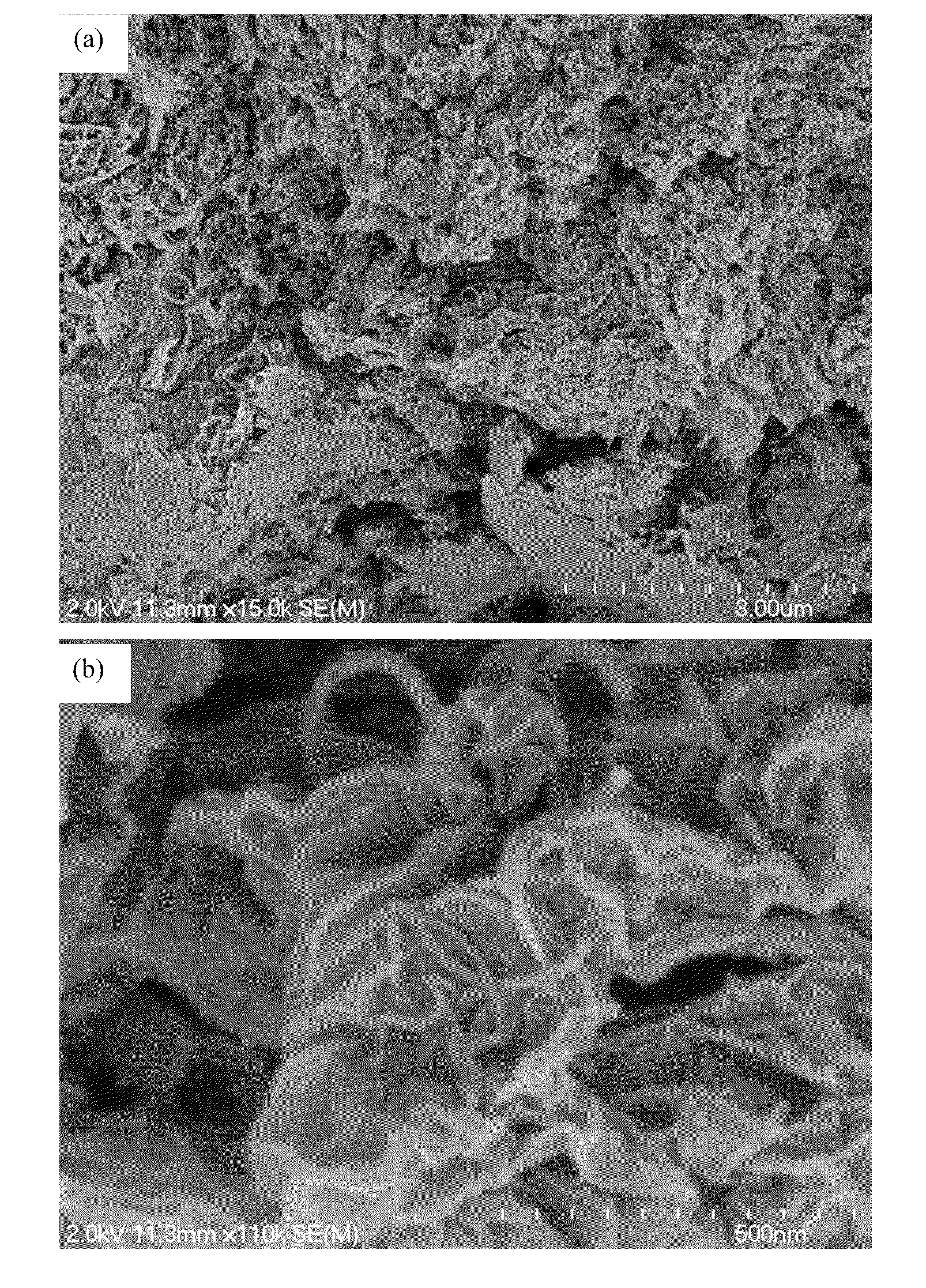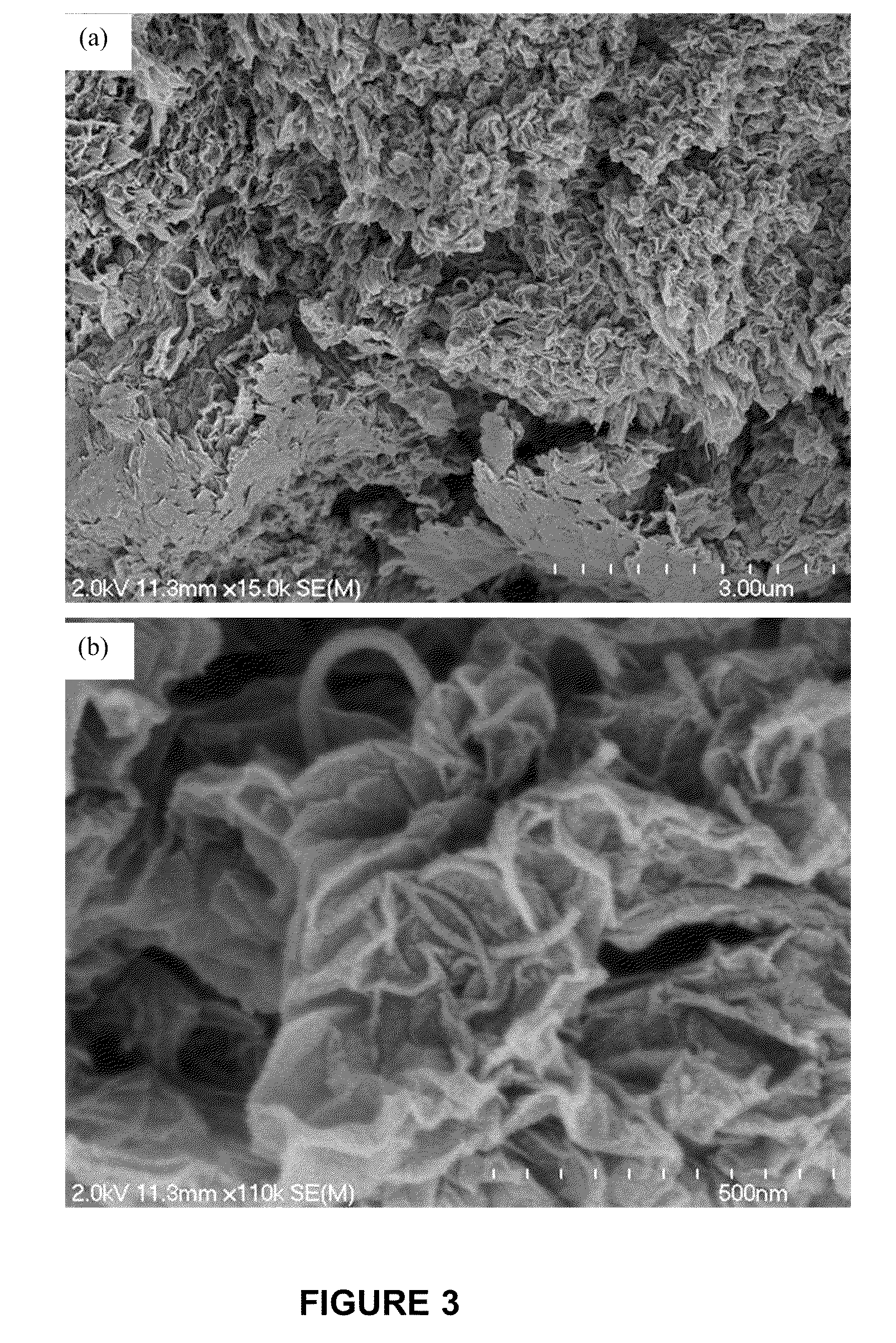Production of mechanically exfoliated graphene and nanoparticle composites comprising same
a technology of graphene and nanoparticles, applied in the direction of non-metal conductors, conductors, metal/alloy conductors, etc., to achieve the effect of high surface area
- Summary
- Abstract
- Description
- Claims
- Application Information
AI Technical Summary
Benefits of technology
Problems solved by technology
Method used
Image
Examples
example 1
[0083]Graphite oxide prepared from natural graphite flakes (325 mesh, Alfa-Aesar) by Hummer's method was used as the starting material. In a typical procedure, 1 g of graphite oxide was dispersed in 500 g water. After sonication for 2 hours a clear, brown dispersion of graphene oxide was formed. Thereafter, 50 mg of multi-walled carbon nanotubes was added to the graphene oxide dispersion with stirring. 1 g of hydrazine in 5 grams of water having a pH of about 7-8 (adjusted with NaHCO3) was added to the mixture. The mixture was maintained at about 80° C. for 1 hr under constant stirring. During reduction, the dark brown dispersion turned black and aggregation was observed at the end of the reduction step. Nanospacer-graphene composite material was separated from the dispersion by filtration. After rinsing with water several times, the nanospacer-graphene composite material was thermally treated in nitrogen at 800° C. for 2 hrs.
[0084]Referring to FIG. 3, scanning electron microscopy (...
example 2
[0085]Graphite oxide prepared from natural graphite flakes (325 mesh, Alfa-Aesar) by Hummer's method was used as the starting material. In a typical procedure, 1 g of graphite oxide was dispersed in 500 g water. After sonication for 2 hours a clear, brown dispersion of graphene oxide was formed. Thereafter, 50 mg of acetylene black was added to the graphene oxide dispersion with stirring. 1 g of hydrazine in 5 grams of water having a pH of about 7-8 (adjusted with NaHCO3) was added to the mixture. The mixture was maintained at about 80° C. for 1 hr under constant stirring. During reduction, the dark brown dispersion turned black and aggregation was observed at the end of the reduction step. Nanospacer-graphene composite material was separated from the dispersion by filtration. After rinsing with water several times, the nanospacer-graphene composite material was thermally treated in nitrogen at 800° C. for 2 hrs.
[0086]Referring to FIG. 4, SEM images of the nanospacer-graphene compos...
example 3
[0087]Graphite oxide prepared from natural graphite flakes (325 mesh, Alfa-Aesar) by Hummer's method was used as the starting material. In a typical procedure, 1 g of graphite oxide was dispersed in 500 g water. After sonication for 2 hours a clear, brown dispersion of graphene oxide was formed. Thereafter, 9.5 g of 3-(N,N-dimethyldodecylammonio) propane sulfonate and 4.93 g of H2PtCl6 in 50 g water was added to the graphene oxide dispersion with stirring. 170 g ethylene glycol was added to the mixture after adjustment to about of about 7-8 using sodium carbonate. The mixture was maintained at about 100° C. for 2 hrs under constant stirring. During reduction, the dark brown dispersion turned black and aggregation was observed at the end of the reduction step. Nanospacer-graphene composite material was separated from the dispersion by filtration. After rinsing with water and methanol thoroughly, the nanospacer-graphene composite material was dried at 70° C. for 15 hrs.
[0088]Referring...
PUM
| Property | Measurement | Unit |
|---|---|---|
| thickness | aaaaa | aaaaa |
| temperature | aaaaa | aaaaa |
| temperature | aaaaa | aaaaa |
Abstract
Description
Claims
Application Information
 Login to View More
Login to View More - R&D
- Intellectual Property
- Life Sciences
- Materials
- Tech Scout
- Unparalleled Data Quality
- Higher Quality Content
- 60% Fewer Hallucinations
Browse by: Latest US Patents, China's latest patents, Technical Efficacy Thesaurus, Application Domain, Technology Topic, Popular Technical Reports.
© 2025 PatSnap. All rights reserved.Legal|Privacy policy|Modern Slavery Act Transparency Statement|Sitemap|About US| Contact US: help@patsnap.com



